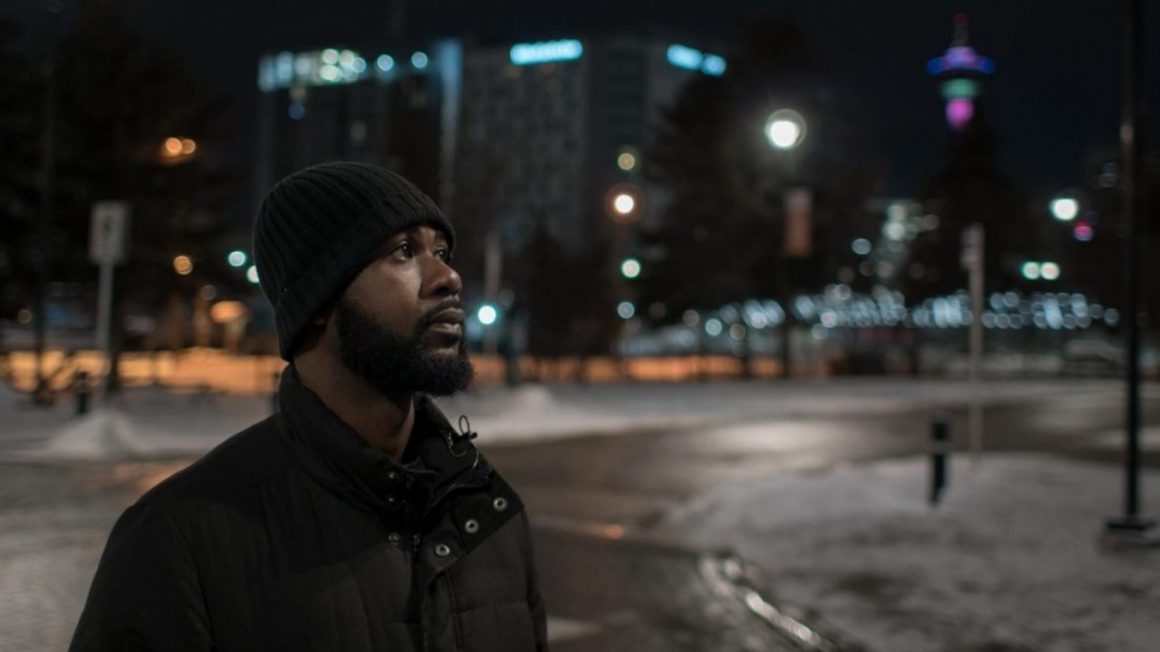
No Visible Trauma: The cinematic investigation of police brutality in Calgary
By Anastasiia Gushchina, April 1 2021—
On March 3, Hot Docs Canadian International Documentary Festival opened streaming of the documentary No Visible Trauma. The film investigates the issue of systematic police brutality in Calgary. It is exhibited as a part of the For Viola series, which focusses on stories told by Black, Indigenous and people of colour filmmakers.
The documentary starts with a cold opening, showing long shots of a snowy East Village accompanied by a recording of a call made to 911. We hear a male voice repeating: “Please, I’m freezing. They just picked me up and dropped me off somewhere cold.”
Who are they? The police.
Godfred Addai-Nyamekye, a young Black man living in Calgary, was assaulted twice by police officers on Dec. 28, 2013. He was driving his friends from a house party and the car got stuck in the snow. A passing-by police van pulled behind Addai-Nyamekye’s car. The officers approached the man and wrestled him to the ground. They handcuffed him, threw him into the van and drove to East Village. There, they pulled him out, took off the handcuffs and told him to “beat it.” The time was 3:40 a.m. and the temperature was -18 degrees celsius with the windchill. Wearing only a light tracksuit, Addai-Nyamekye was left alone in the snow, in the middle of an area that he wasn’t familiar with. Not knowing what else to do, he called 911.
The officers who came to the place of the incident tased Addai-Nyamekye who got scared and tried to run away. The police handcuffed him for the second time, put him to the ground and beat him up. Godfred received severe head and back injuries that he still has not recovered from, seven years later.
Throughout the film, viewers learn about two more instances of assault committed by officers from the Calgary Police Service (CPS). These incidents are narrated by the members of the victims’ families, as the victims themselves did not survive.
Using a conventional documentary structure, the film presents testimonies of witnesses, victims and experts. These recordings are supported by shocking and graphic images from surveillance cameras from some CPS units, as well as by statistics of Canada-wide incidents of police shootings. The stats show, for example, that in 2018 the CPS killed more people than any other police service in the country.
Using these data, the documentary draws attention to the systematic failure of the organization of the police force. It explores the toxic inner environment that encourages harassment and bullying. The documentary also discusses corruption, along with unhealthy working conditions that inevitably influence the behavior of the police officers on the streets. In other words, the film claims that the system itself encourages its members to exceed their authority and break the laws that they are supposed to enforce.
The viewers may ask if there is hope for change. The filmmakers do not give a certain answer. However, they show a recording of the official ceremony of Mark Neufeld accepting his new role as a police chief. Whether he will actually be able to address “the morale problems within the service,” is something the film leaves viewers to speculate.
The name of the film, No Visible Trauma, invites reflection on the stereotypes around the types of violence that prevails in our society — believing that assault or abuse leaves a physical trace and only the existence of this trace can classify action as brutality. Yet what the documentary is arguing for is that trauma is very much visible. The victims of police violence represented in the film, along with family members of those who did not survive, are the living proof of it.
Finally, even though the documentary makes a broader overview of the issues present at the CPS, one thing stays obvious — the racial factor is still very much at play when it comes to using violence against civilians. The film ends with Addai-Nyamekye giving a speech at the Calgary protest march which happened as a part of the Black Lives Matter movement in 2020. Surrounded by a group of supporters, he shouts, “Stay strong and keep fighting.” This is a call for all of us — keep fighting against systemic racism, oppression and injustice. Police brutality will not stand. Nor will fear.
The film will be available for streaming until Apr. 1, 2021, and is free for registered users. You can also support the festival, the series and the project by making a $10 donation with your free ticket purchase.
